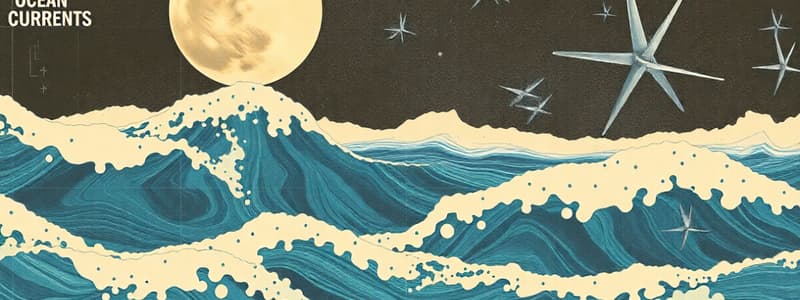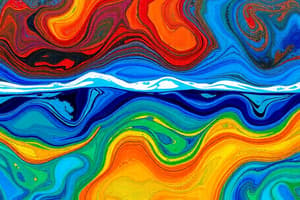Podcast
Questions and Answers
Which of the following describes a spring tide?
Which of the following describes a spring tide?
- The smallest tidal movements
- Tidal movements that occur when the sun and moon are at right angles
- The largest tidal movements when the earth, sun, and moon are in line (correct)
- Tides that occur only in the summer
The Coriolis effect causes winds and currents to change direction due to Earth's rotation.
The Coriolis effect causes winds and currents to change direction due to Earth's rotation.
True (A)
What is the term for the vertical movement of water from the ocean floor caused by wind?
What is the term for the vertical movement of water from the ocean floor caused by wind?
upwelling
The __________ is the submerged part of the edge of the continents that slopes down gradually.
The __________ is the submerged part of the edge of the continents that slopes down gradually.
What is the main cause of deep ocean currents?
What is the main cause of deep ocean currents?
Match the following terms with their definitions:
Match the following terms with their definitions:
Buoyancy refers to the downward force experienced by objects submerged in a fluid.
Buoyancy refers to the downward force experienced by objects submerged in a fluid.
__________ is the process when a gas turns into a liquid, such as steam condensing on a mirror.
__________ is the process when a gas turns into a liquid, such as steam condensing on a mirror.
Flashcards
Continental Shelf
Continental Shelf
The submerged part of the edge of the continents that slopes down gradually away from land before dropping steeply downwards.
Continental Slope
Continental Slope
The submerged area of the edge of the continents, beyond the continental shelf, that drops steeply down to the ocean basin.
Ocean Current
Ocean Current
The flow of water in a specific direction.
Surface Current
Surface Current
Signup and view all the flashcards
Deep Current
Deep Current
Signup and view all the flashcards
Spring Tide
Spring Tide
Signup and view all the flashcards
Neap Tide
Neap Tide
Signup and view all the flashcards
Coriolis Effect
Coriolis Effect
Signup and view all the flashcards
Study Notes
Hydrosphere
- All water on Earth, including atmosphere and lithosphere
- Abyssal Plain: Wide, open ocean floor regions between continents
- Continental Shelf: Submerged edge of continents, sloping gradually away from land
- Continental Slope: Steeply descending area beyond the continental shelf
- Ocean Current: Water flow in a direction
- Surface Current: Driven by wind, Earth's spin, and continental shapes, top 200 meters
- Deep Current: Driven by temperature and salinity differences, below 200 meters
- Tidal Movements:
- Spring Tide: Largest tides, Earth, sun, and moon aligned
- Neap Tide: Smallest tides, sun and moon at right angles
- Coriolis Effect: Change in wind and current direction due to Earth's rotation
- El Niño: Pacific Ocean warming, unusual weather (more rain, warmer temps)
- La Niña: Pacific Ocean cooling, cooler temps, more storms
- Abiotic Factors in Ocean:
- Dissolved Oxygen >5 mg/L
- Phosphate <10 g/L
- pH 5.5-8.5
- Aquaculture: Growing/harvesting marine species in contained areas
- Tsunami: Earthquakes, volcanic eruptions, or underwater landslides cause tsunamis
- Upwelling: Vertical water movement from ocean floor to surface, often caused by wind
Properties of Matter
- Density: Mass per unit volume (how tightly packed)
- Buoyancy: Upward force on submerged/floating objects
- Condensation: Gas to liquid (e.g., steam to water)
- Deposition: Gas to solid (e.g., frost)
- Sublimation: Solid to gas (e.g., dry ice)
- Fluid: Any substance that flows (liquid or gas)
- Pascal's Principle: Pressure applied to a fluid in a closed container is distributed equally
- Force: Anything causing change in motion (push or pull)
- Mass: Amount of matter an object has
- Weight: Force of gravity acting on an object's mass
- Archimedes' Principle: Buoyant force equals weight of displaced fluid
- Pressure: Force applied over an area
Atmospheric Pressure & Fluid Properties
- Atmospheric Pressure: Weight of air above, decreases with altitude
- Boyle's Law: Increased pressure on a gas reduces its volume
- Compressibility: Ability of a substance to be squeezed into a smaller space
- Hydraulic System: Uses liquid to transmit force, magnifying the force applied
- Viscosity: Fluid's thickness/resistance to flow
- Pneumatic System: Uses gas to transmit force, like in a bicycle pump
Studying That Suits You
Use AI to generate personalized quizzes and flashcards to suit your learning preferences.




